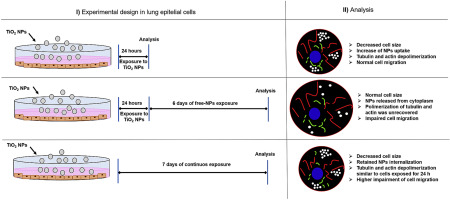当前位置:
X-MOL 学术
›
Chem. Biol. Interact.
›
论文详情
Our official English website, www.x-mol.net, welcomes your
feedback! (Note: you will need to create a separate account there.)
Irreversible disruption of the cytoskeleton as induced by non-cytotoxic exposure to titanium dioxide nanoparticles in lung epithelial cells.
Chemico-Biological Interactions ( IF 4.7 ) Pub Date : 2020-03-26 , DOI: 10.1016/j.cbi.2020.109063 Alejandro Déciga-Alcaraz 1 , Norma L Delgado-Buenrostro 2 , Octavio Ispanixtlahuatl-Meráz 1 , Verónica Freyre-Fonseca 3 , José O Flores-Flores 4 , Adriana Ganem-Rondero 5 , Felipe Vaca-Paniagua 6 , María Del Pilar Ramos-Godinez 7 , Rocío Morales-Barcenas 8 , Yesennia Sánchez-Pérez 8 , Claudia M García-Cuéllar 8 , Yolanda I Chirino 3
Chemico-Biological Interactions ( IF 4.7 ) Pub Date : 2020-03-26 , DOI: 10.1016/j.cbi.2020.109063 Alejandro Déciga-Alcaraz 1 , Norma L Delgado-Buenrostro 2 , Octavio Ispanixtlahuatl-Meráz 1 , Verónica Freyre-Fonseca 3 , José O Flores-Flores 4 , Adriana Ganem-Rondero 5 , Felipe Vaca-Paniagua 6 , María Del Pilar Ramos-Godinez 7 , Rocío Morales-Barcenas 8 , Yesennia Sánchez-Pérez 8 , Claudia M García-Cuéllar 8 , Yolanda I Chirino 3
Affiliation

|
Exposure to TiO2 NPs induces several cellular alterations after NPs uptake including disruption of cytoskeleton that is crucial for lung physiology but is not considered as a footprint of cell damage. We aimed to investigate cytoskeleton disturbances and the impact on cell migration induced by an acute TiO2 NPs exposure (24 h) and the recovery capability after 6 days of NPs-free treatment, which allowed investigating if cytoskeleton damage was reversible. Exposure to TiO2 NPs (10 μg/cm2) for 24 h induced a decrease 20.2% and 25.1% in tubulin and actin polymerization. Exposure to TiO2 NPs (10 μg/cm2) for 24 h followed by 6 days of NPs-free had a decrease of 26.6% and 21.3% in tubulin and actin polymerization, respectively. The sustained exposure for 7 days to 1 μg/cm2 and 10 μg/cm2 induced a decrease of 22.4% and 30.7% of tubulin polymerization respectively, and 28.7% and 46.2% in actin polymerization. In addition, 24 h followed 6 days of NPs-free exposure of TiO2 NPs (1 μg/cm2 and 10 μg/cm2) decreased cell migration 40.7% and 59.2%, respectively. Cells exposed (10 μg/cm2) for 7 days had a decrease of 65.5% in cell migration. Ki67, protein surfactant B (SFTPB) and matrix metalloprotease 2 (MMP2) were analyzed as genes related to lung epithelial function. The results showed a 20% of Ki67 upregulation in cells exposed for 24 h to 10 μg/cm2 TiO2 NPs while a downregulation of 20% and 25.8% in cells exposed to 1 μg/cm2 and 10 μg/cm2 for 24 h followed by 6 days of NPs-free exposure. Exposure to 1 μg/cm2 and 10 μg/cm2 for 24 h and 7 days upregulates SFTPB expression in 53% and 59% respectively, MMP2 expression remain unchanged. In conclusion, exposure of TiO2 NPs affected cytoskeleton of lung epithelial cells irreversibly but this damage was not cumulative.
中文翻译:

由于非细胞毒性暴露于肺上皮细胞中的二氧化钛纳米颗粒而引起的细胞骨架不可逆转的破坏。
在NPs摄取后,暴露于TiO2 NPs会诱导几种细胞改变,包括破坏细胞骨架,这对肺部生理至关重要,但不认为是细胞损伤的足迹。我们旨在研究急性TiO2 NPs暴露(24小时)引起的细胞骨架紊乱及其对细胞迁移的影响,以及无NPs处理6天后的恢复能力,从而研究细胞骨架损伤是否可逆。暴露于TiO2 NPs(10μg/ cm2)24小时导致微管蛋白和肌动蛋白的聚合反应分别降低20.2%和25.1%。在微管蛋白和肌动蛋白聚合反应中,暴露于TiO2 NPs(10μg/ cm2)24小时,然后暴露6天无NPs分别降低了26.6%和21.3%。持续暴露7天至1μg/ cm2和10μg/ cm2导致减少了22.4%和30。微管蛋白聚合分别为7%,肌动蛋白聚合为28.7%和46.2%。此外,在无NPs的TiO2 NPs(1μg/ cm2和10μg/ cm2)暴露6天后的24小时内,细胞迁移分别减少了40.7%和59.2%。暴露(10μg/ cm2)7天的细胞的细胞迁移减少了65.5%。Ki67,蛋白质表面活性剂B(SFTPB)和基质金属蛋白酶2(MMP2)被分析为与肺上皮功能相关的基因。结果显示,暴露于10μg/ cm2 TiO2 NP 24小时的细胞中Ki67的上调为20%,暴露于1μg/ cm2和10μg/ cm2的24小时细胞中的Ki67下调为20%和25.8%,随后为6无NP暴露天数。分别暴露于1μg/ cm2和10μg/ cm2 24小时和7天分别使SFTPB表达上调53%和59%,MMP2表达保持不变。结论,
更新日期:2020-03-27
中文翻译:

由于非细胞毒性暴露于肺上皮细胞中的二氧化钛纳米颗粒而引起的细胞骨架不可逆转的破坏。
在NPs摄取后,暴露于TiO2 NPs会诱导几种细胞改变,包括破坏细胞骨架,这对肺部生理至关重要,但不认为是细胞损伤的足迹。我们旨在研究急性TiO2 NPs暴露(24小时)引起的细胞骨架紊乱及其对细胞迁移的影响,以及无NPs处理6天后的恢复能力,从而研究细胞骨架损伤是否可逆。暴露于TiO2 NPs(10μg/ cm2)24小时导致微管蛋白和肌动蛋白的聚合反应分别降低20.2%和25.1%。在微管蛋白和肌动蛋白聚合反应中,暴露于TiO2 NPs(10μg/ cm2)24小时,然后暴露6天无NPs分别降低了26.6%和21.3%。持续暴露7天至1μg/ cm2和10μg/ cm2导致减少了22.4%和30。微管蛋白聚合分别为7%,肌动蛋白聚合为28.7%和46.2%。此外,在无NPs的TiO2 NPs(1μg/ cm2和10μg/ cm2)暴露6天后的24小时内,细胞迁移分别减少了40.7%和59.2%。暴露(10μg/ cm2)7天的细胞的细胞迁移减少了65.5%。Ki67,蛋白质表面活性剂B(SFTPB)和基质金属蛋白酶2(MMP2)被分析为与肺上皮功能相关的基因。结果显示,暴露于10μg/ cm2 TiO2 NP 24小时的细胞中Ki67的上调为20%,暴露于1μg/ cm2和10μg/ cm2的24小时细胞中的Ki67下调为20%和25.8%,随后为6无NP暴露天数。分别暴露于1μg/ cm2和10μg/ cm2 24小时和7天分别使SFTPB表达上调53%和59%,MMP2表达保持不变。结论,











































 京公网安备 11010802027423号
京公网安备 11010802027423号